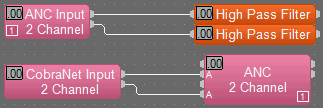ANC Input
Automatic Noise Compensation (ANC) Inputs provide support for applications where automatic adjustment of zone level based on the ambient noise level is needed. When the ANC Input component is selected from the Object Toolbar, an ANC Initialization dialog is produced.
Initialization Dialog

| Name | Description |
| Channel Count | Provides a dropdown where the number of channels can be selected. If Custom is selected from the drop-down list the number of channels can be specified between 1 and 16. |
| Include ANC Input Block | specifies whether both the ANC Input and ANC processing blocks are created (checked) or only the ANC processing block (unchecked). |
DSP Block Representation

The ANC functionality is comprised of an ANC Input block and an ANC processing block. The two blocks will have a number in the lower corner, assigned by the software, which indicates which blocks are associated with each other, which is important when there are multiple ANC Inputs in the system. The ANC Input block contains the microphone preamp settings for the ambient sensing input and has one output connection per channel. The processing block has two inputs per channel, the program input and the ambient sensing input, designated A. Normally, the outputs of the ANC Input block are wired to the A inputs of the ANC processing block. However, the input and processing blocks can be separated, so the ambient sensing inputs can arrive via digital audio inputs from the network, for example. In this instance, the ANC Input block could still be used to bring analog mic or line inputs into Tesira.

Control Dialog
ANC Input Block
Double clicking on the ANC Input block produces a control dialog window.

| Name | Description | Range |
| Device IO | Indicates which physical hardware input is associated with that software channel. For SERVER and SERVER-IO devices is formatted as x.y - where x indicates which card slot and y indicates which channel on the card. | |
| Peak | a software indicator that flashes when the input signal is within 3dB of clipping. | |
| Gain | sets the amount of analog gain for that channel and is used to compensate for differing input levels (mic or line). | 0-66 in 6dB steps |
| Phantom Power | assigns +48 Volt phantom power to the input for use with condenser microphones |
ANC Processing Block
Double clicking on the ANC processing block produces a control dialog window.

Use the Channel drop down menu to specify a channel for viewing/editing.
The Mic meter shows the signal level at the A (ambient sensing) input of the ANC processing block. Program shows the signal level at the program input. Ambient shows the level of the A input after any program audio signal components in the ambient sensing mic have been filtered out. The Comp meter shows how much gain compensation will be applied to the program input.
Under the Compensation heading, Ratio determines the how gain compensation is applied when the ambient level is above the threshold. It specifies the amount in dB the program gain is increased for every 1dB the Ambient level exceeds the ambient threshold. Values in the range of 0.25 to 1dB are possible. Max specifies the maximum amount of gain the ANC process can apply to the program input. Values in the range of 0 to 25dB are possible.
Under the Response Time heading, Up and Down determine how quickly a calculated gain change is applied to the program signal. Separate values can be programmed for how quickly gain is applied when the ambient level increases and how quickly it is removed when the ambient level decreases. Values in the range of 500 to 300,000 ms can be set.
Under the Ambient heading, Threshold (dBu) specifies the level of the ambient sensing input above which the ANC process will begin to add gain to the program audio. If the ambient sensing input falls below this threshold, ANC will have no effect on the program audio. RT-60 (ms) is used to optimize the cancellation of program audio from the ambient sensing input. In large, reverberant spaces, it is important to let the filter know how long to listen for reflected versions of the program audio which may by picked up by the ambient sensing microphone.
The Bypass button stops the ANC process and returns the program signal to its normal, uncompensated level.